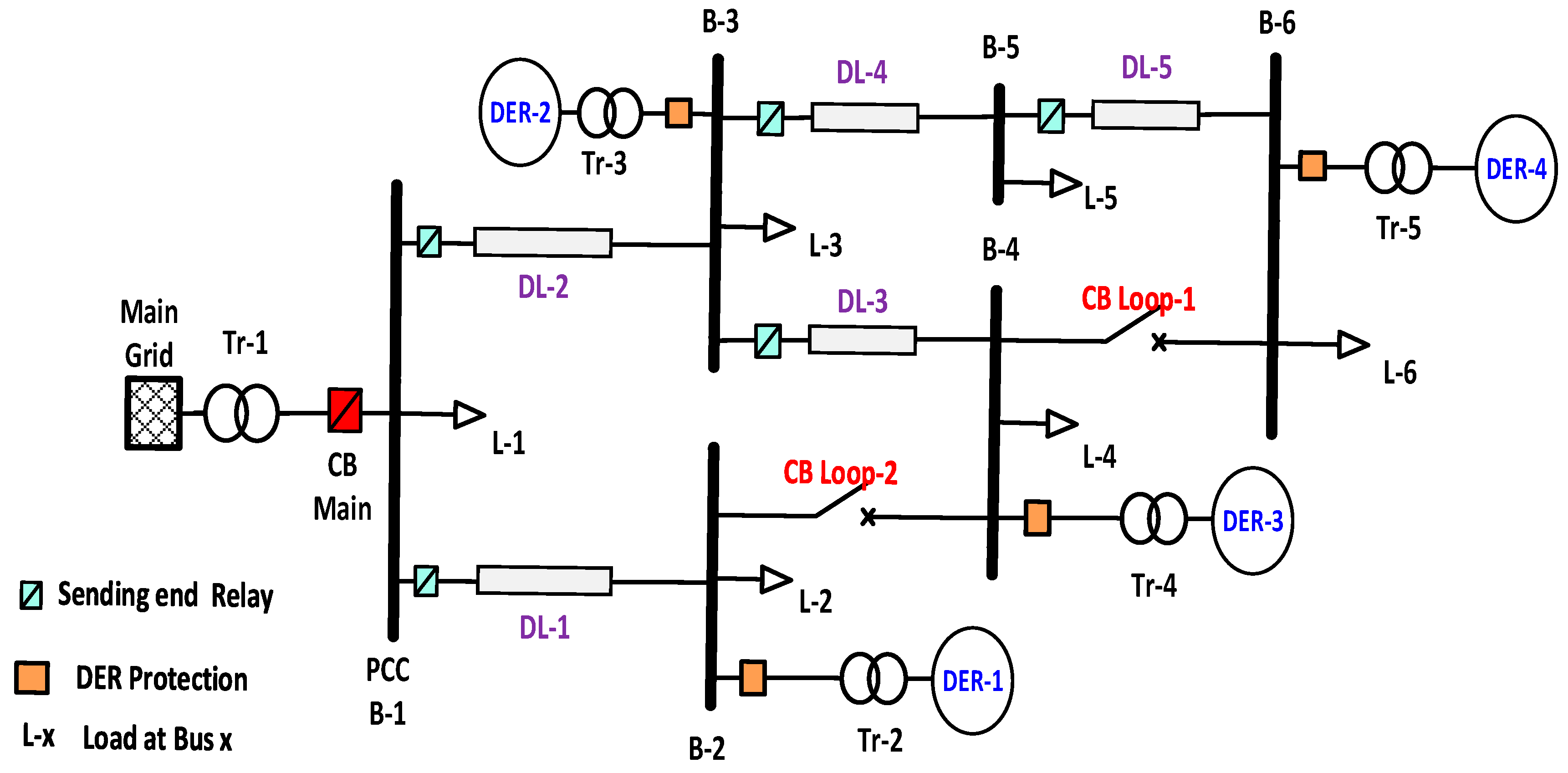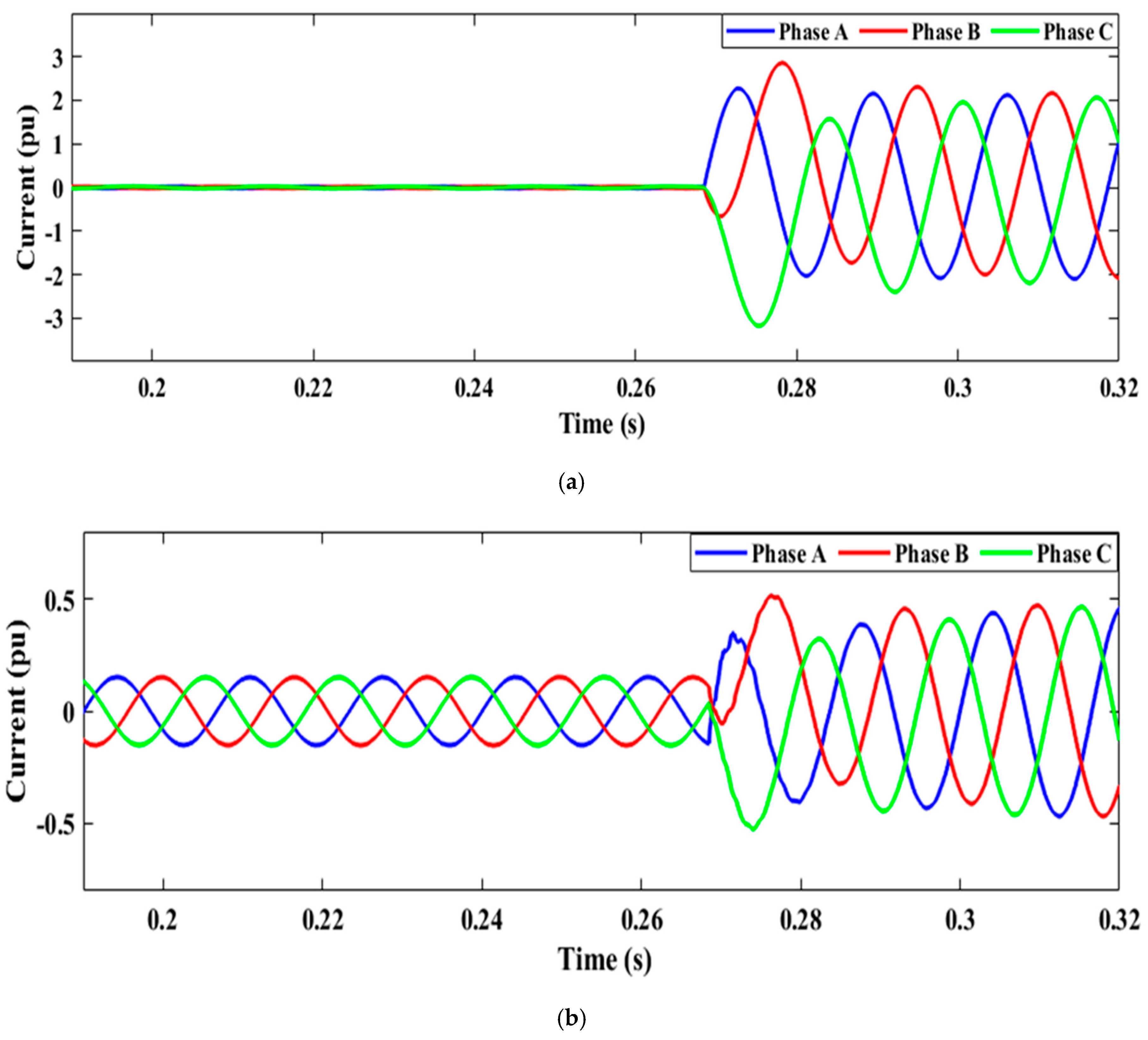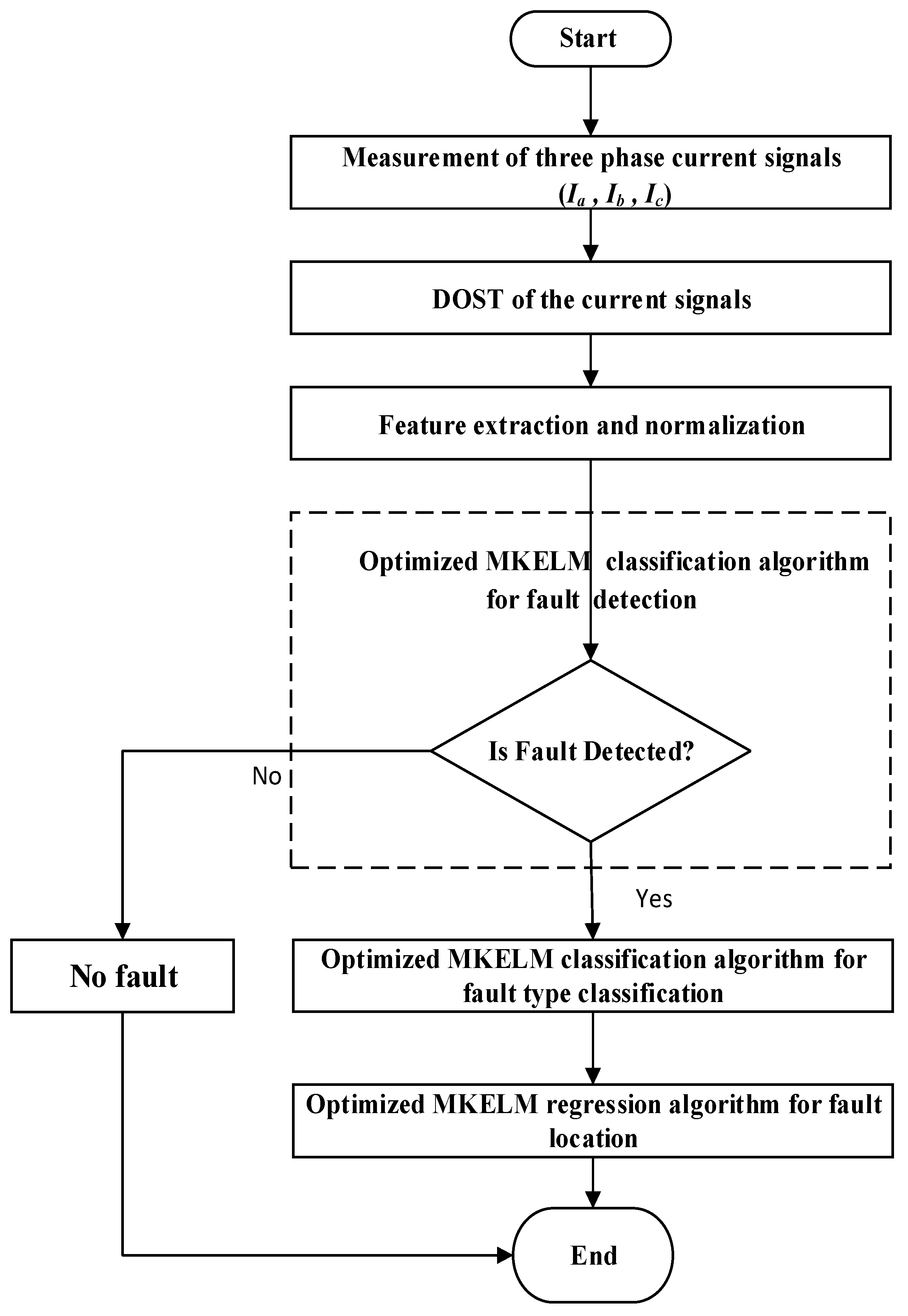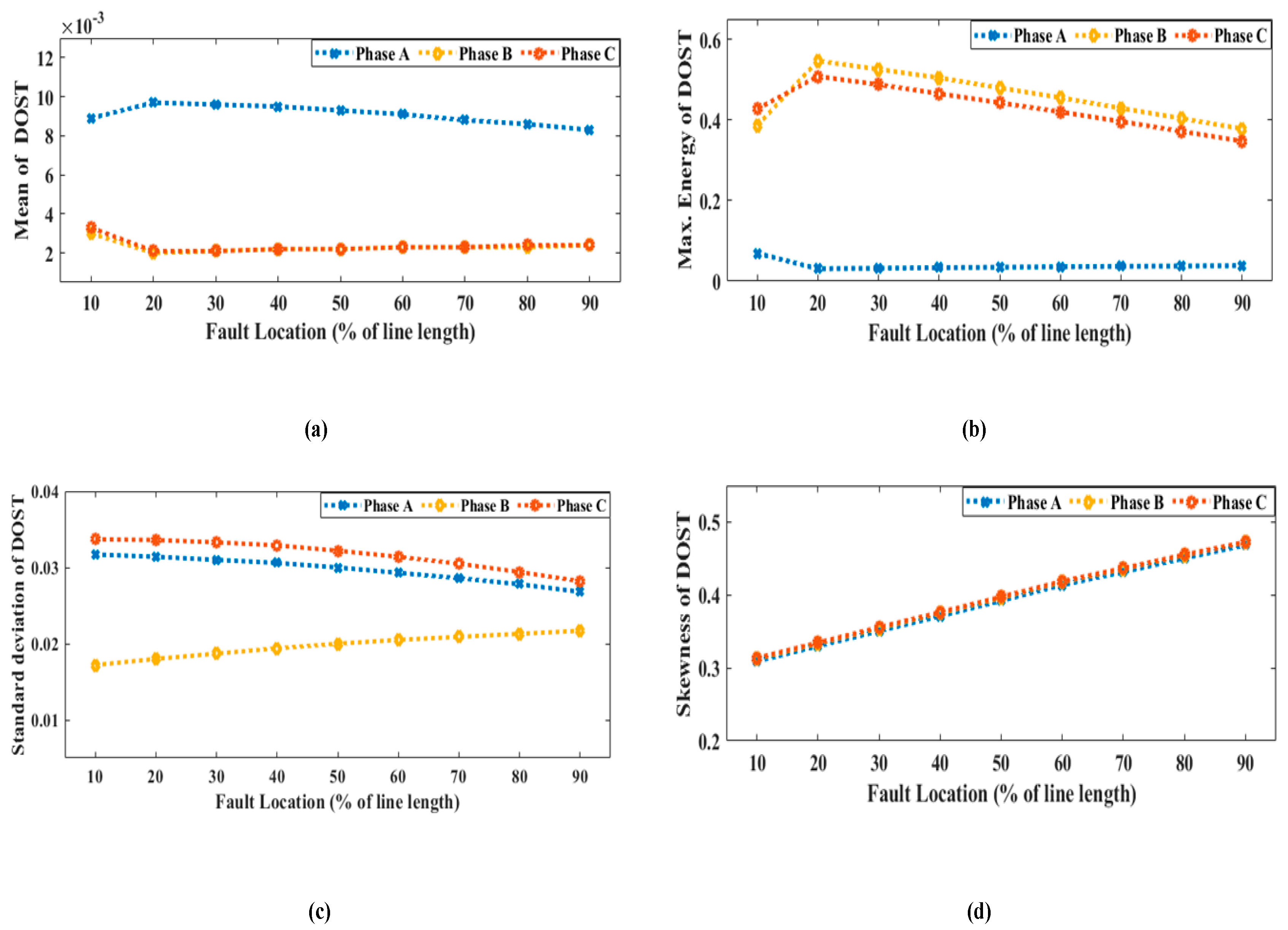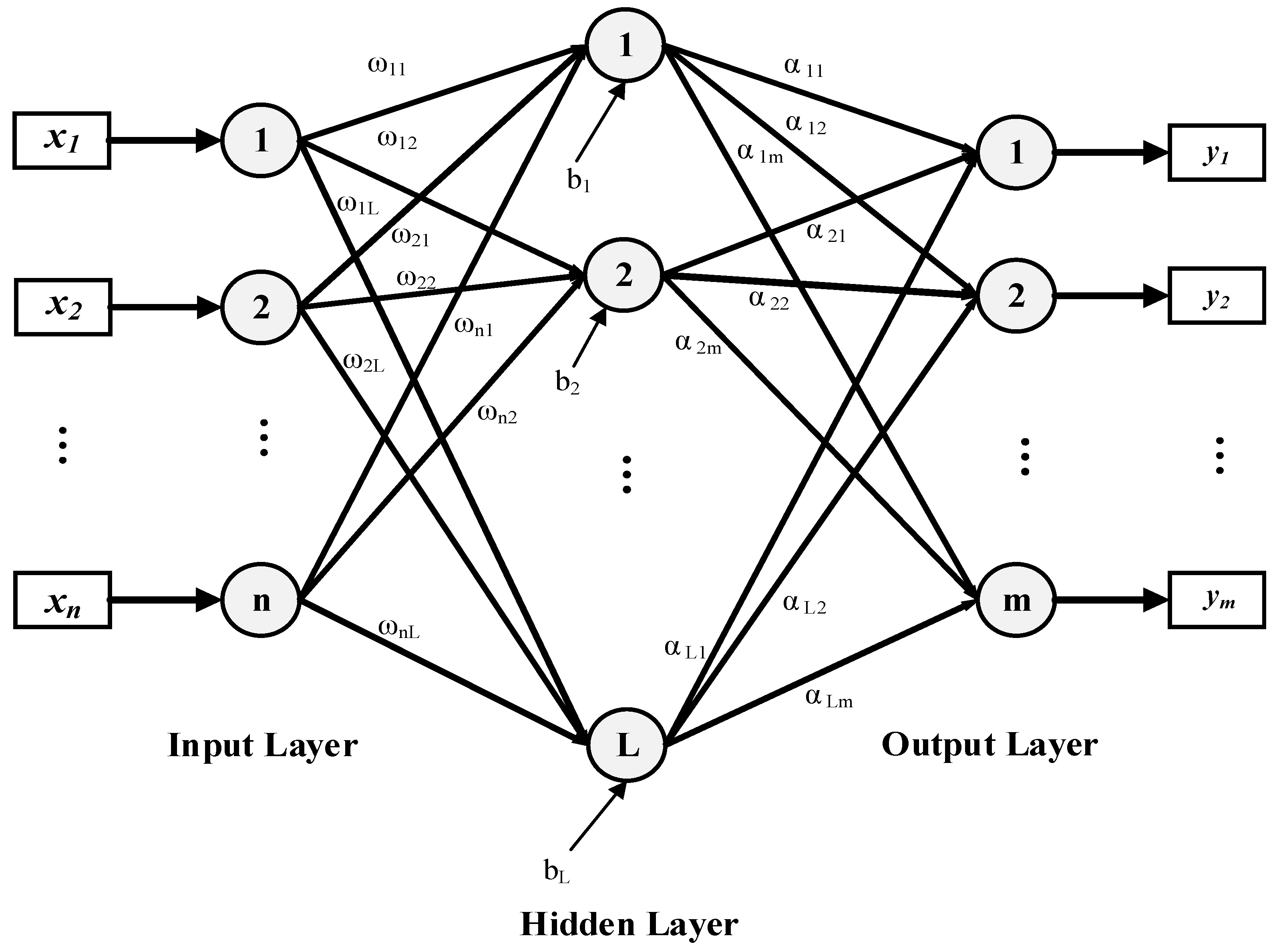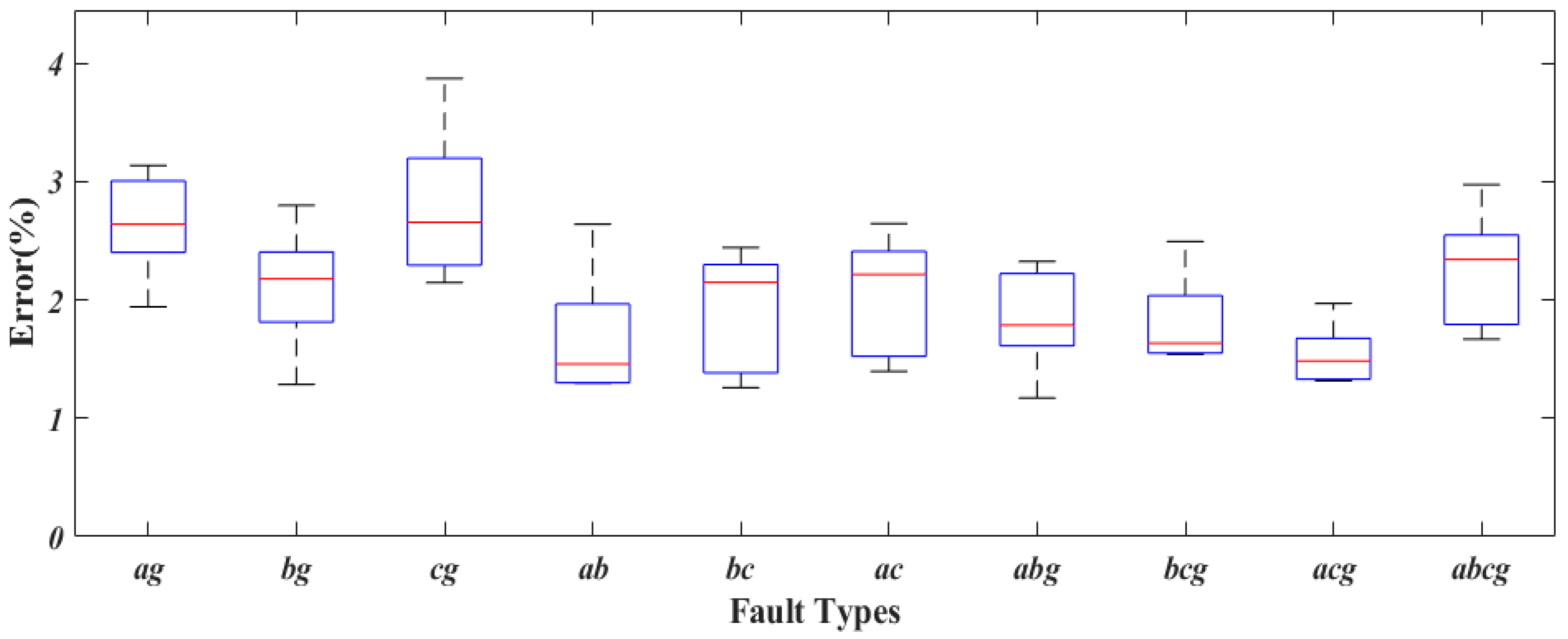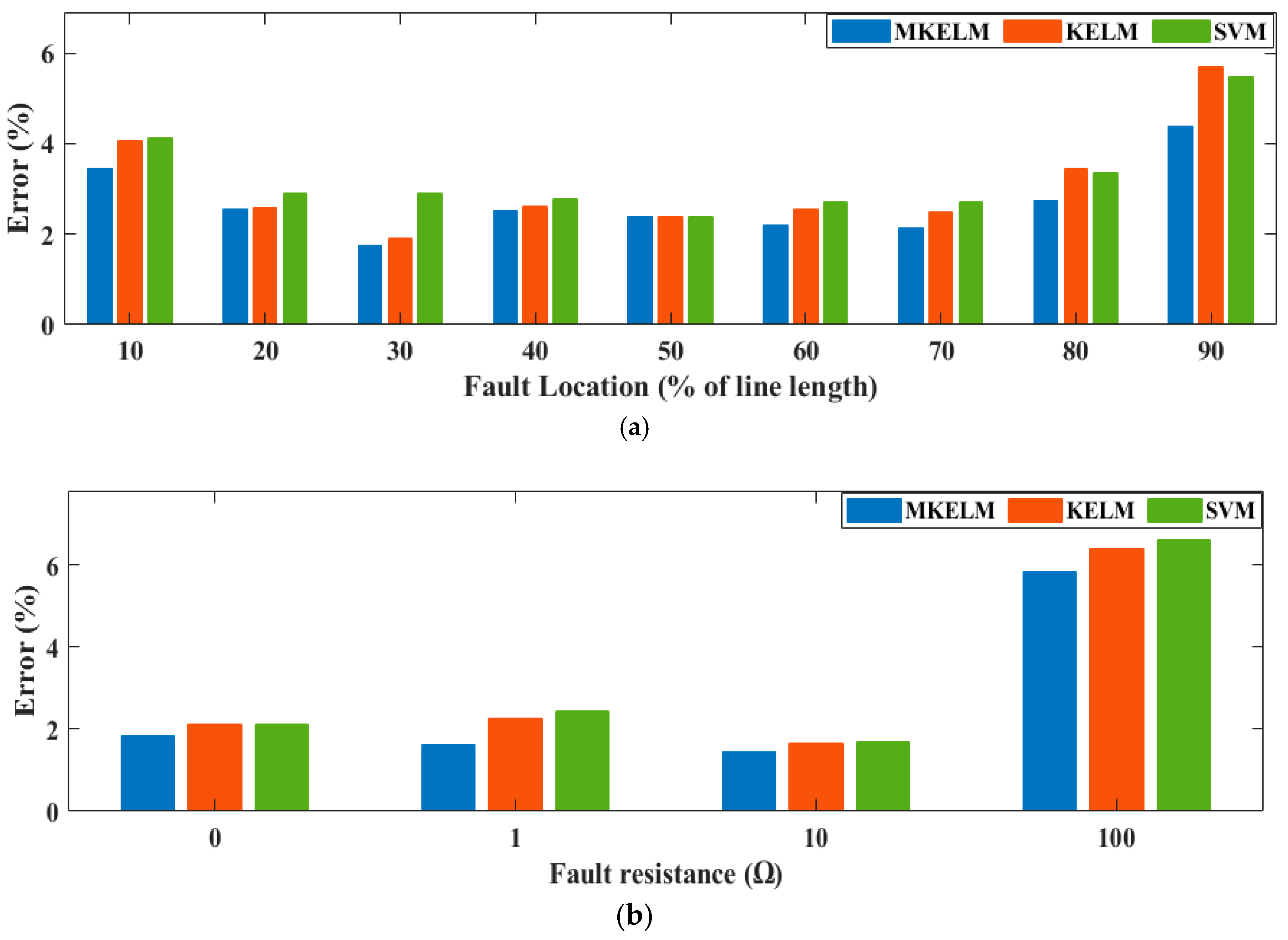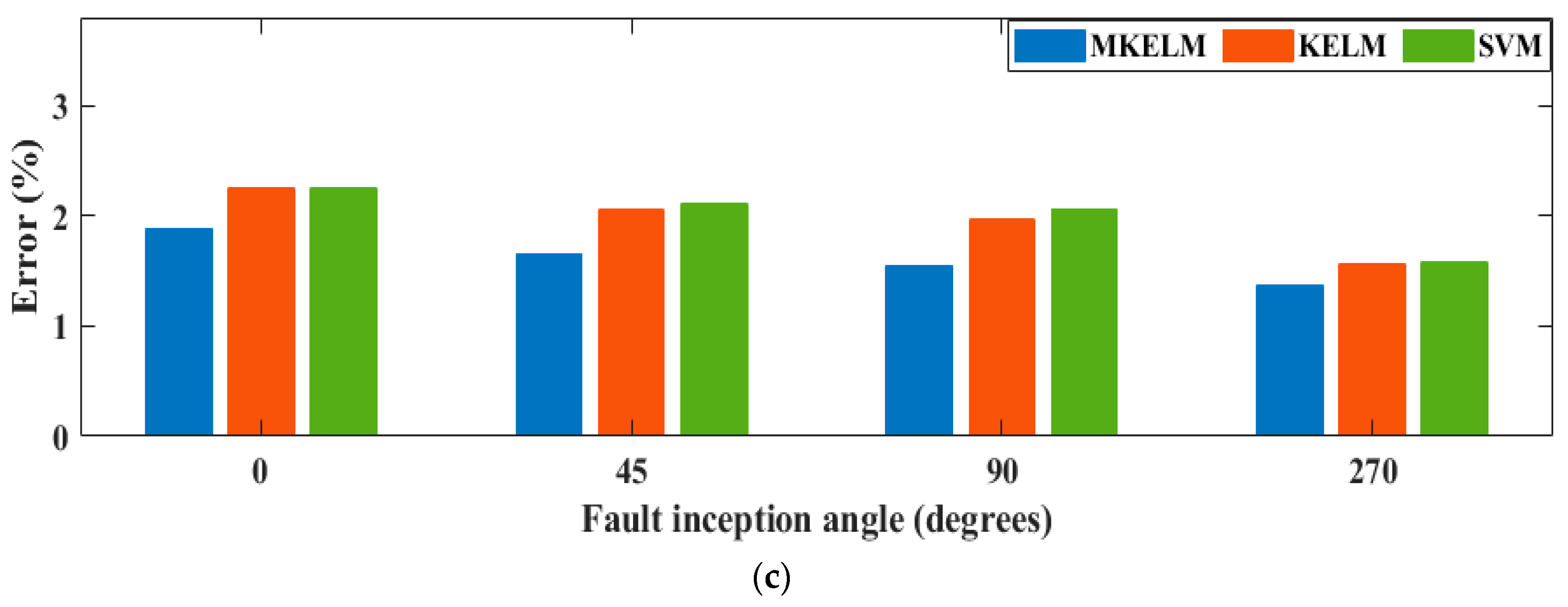1. Introduction
The structure of power distribution systems has been reformed owing to the penetration of distributed energy resources (DERs) into conventional distribution systems in the form of microgrids. A microgrid is a small-scale power supply system comprising several DERs, energy storage systems, sensitive and non-sensitive loads, communication facilities, smart switches, and a centralized or decentralized control system [
1,
2]. Microgrids can operate either in the grid-tied mode, in which part of the loads is supported by the main grid, or in the islanded mode, in which the microgrid operates autonomously. A microgrid can improve the power reliability, quality, stability, and security of the conventional distribution systems. Nevertheless, the integration of microgrids into distribution systems presents challenges related to protection, control, and energy management [
3,
4,
5].
The protection methods for transmission lines and conventional distribution systems cannot be directly applied to a microgrid, owing to the bidirectional power flow, the presence of looped configuration, and the significant variation of fault currents in the various modes of microgrids. The magnitude of the fault current varies in microgrids depending on the operation mode (grid-tied or islanded), network configuration (radial or looped topology), and type of DERs (synchronous generator- or inverter-based DERs) [
6,
7,
8]. Hence, we need adaptive or intelligent fault detection, classification, and location methods for immediate clearing of faults from microgrids.
In previous studies, various methods have been investigated for the detection and diagnosis of faults in microgrids [
9,
10,
11,
12,
13]. In [
14], a model-based fault detection method for microgrids was proposed. The authors developed a mathematical model to analyze and avoid nuisance and blinding tripping. However, the performance of the proposed method was not investigated under measurement uncertainty. In [
15], a mathematical morphology-based fault detection scheme for microgrids was proposed. In [
16], fault type classification in a microgrid was proposed based on the magnitude and phase angle of positive and zero sequence voltages. However, the selection of thresholds for fault classification was not adaptive. An impedance-based fault location method for distribution systems in the presence of DERs was proposed in [
17,
18,
19]. However, these methods are not effective when the distribution lines are short, the distribution system has DERs and laterals, and the fault resistance is unknown. In [
20,
21,
22], a traveling waves-based fault location method for distribution systems in the presence of DERs was proposed. However, these methods require a measurement unit with a high sampling rate and high-speed communication.
Recently, a combination of digital signal processing methods and machine learning tools have gained significant attention for the detection and diagnosis of faults in microgrids. In [
23], a wavelet transform-based decision tree (DT) for the detection and classification of faults in a microgrid was presented. In [
24], a combination of the discrete Fourier transform (DFT) and a DT-based data-mining model was used for the detection and classification of faults in a microgrid. In [
25], Hilbert–Huang transforms and machine learning, such as a support vector machine (SVM), a Naive Bayes classifier (NBC), and an extreme learning machine (ELM), were used for the detection and classification of faults in microgrids. In [
26], the combination of discrete wavelet transform (DWT) and an ensemble of k-nearest neighbor (k-NN) was used for fault detection and classification in microgrids. In [
27], a combination of DWT and ELM was used for microgrid mode detection, section identification, and fault classification. In [
28], a combination of the DWT and deep neural networks was used for fault type/phase classification and location detection in microgrids. In [
29], optimal wavelet functions (matching pursuit) and machine learning methods such as DT, k-NN, SVM, and NBC were used for fault classification. A semi-supervised machine learning-based fault detection and classification method was presented in [
30]. In [
31], the combination of DWT and a Taguchi-based artificial neural network was used for detection, classification, and localization fault in microgrids. However, most of the aforementioned methods do not consider location of the fault in microgrids or the effect of measurement noise on the classification and location of the fault in microgrids.
In this paper, the intelligent fault classification and location identification method is proposed for microgrids by combining the discrete orthonormal Stockwell transform (DOST) and the multi-kernel ELM (MKELM). The proposed method first preprocesses one cycle of post-fault current signals retrieved from sending-end relays of the microgrid using the DOST. The DOST is a discrete and pared-down version of the redundant Stockwell transform (S-transform), which is used to decompose time-domain signals into the time-frequency domain [
32]. From the output coefficients of DOST, useful statistical features are extracted. Then, the extracted features are normalized and fed into classification and regression algorithms of the MKELM for fault classification and location in microgrids. The MKELM inherits the properties of the ELM; e.g., it exhibits extremely fast learning speed, good generalization performance, and is less prone to local minima and overfitting than gradient-based learning algorithms [
33]. The parameters of the MKELM are optimized using a genetic algorithm (GA) to obtain good classification and location performance. A GA is used due to its simplicity and efficiency, it is easier to converge, and it gets a better global solution than other methods. The performance of the proposed method is tested for all types of faults for a wide range of operating and fault conditions with radial and loop microgrid topologies in the grid-tied and islanded modes. The performance of the proposed method is validated by comparing the results with those of single-kernel ELM (KELM)- and SVM-based methods and is evaluated with measurement noises in the current signals. The test results indicate that the MKELM achieves higher fault classification and location performance than the KELM and SVM.
The main contributions of this paper can be highlighted as follows:
A non-redundant and efficient version of S-transform (DOST) is used for feature extraction from fault current signals.
A multi-kernel ELM (MKELM) method is used as an intelligent fault detection, classification, and location method in a microgrid.
A genetic algorithm (GA) is used for optimizing the parameters of MKELM in order to obtain good generalization performance.
The development of a robust microgrid fault detection, classification, and location identification method applicable to both islanded and grid-tied mode of operation with radial and looped topologies of microgrids.
The remainder of this paper is organized as follows.
Section 2 presents a brief overview of the DOST.
Section 3 describes the studied microgrid test system.
Section 4 discusses the proposed method. The simulation results are presented in
Section 5, and conclusions are drawn in
Section 6.
2. Discrete Orthonormal S-Transform
The S-transform is a time-frequency analysis method, which is extended from the short-time Fourier transform (STFT) and the wavelet transform [
34]. The S-transform combines the absolute phase-retaining properties of the Fourier transform with the frequency-dependent analysis and multi-resolution properties of the wavelet transform. The continuous S-transform of a time-series signal
x(
t) with frequency
f and time variable
t and
τ is defined as [
34,
35]:
The discrete version of the S-transform, with time samples (
p), frequency steps (
n), and the total number of samples (
N), can be expressed as [
34,
35]:
where
n,
p = 0, 1, 2, ...,
N − 1 and
is the DFT of the sampled signals
x[
mT] and given as [
34,
35]:
The DOST is a non-redundant and efficient version of the S-transform that resolves many of the memory and computational issues of the S-transform [
35]. The DOST reduces the redundancy of the S-transform by partitioning the output of the S-transform into
N regions, each of which is represented by a coefficient. The DOST is represented by a set of orthonormal basis functions that localize the Fourier spectrum of the signal and retain the advantageous phase properties of the S-transform. The DOST coefficients can be computed using the inner products between sampled signals
x[
mT] and a set of orthonormal basis functions
[
34,
35].
where
ν is the center of a frequency band,
β is the width of a frequency band, and
τ is the location in time. The output of the DOST is an
N × 1 complex vector that represents time-frequency efficiently, and the elements of the vector are linearly independent.
The main advantages of the DOST are its high computational efficiency, low memory requirements, immunity to measurement noise, and effectiveness for analyzing non-stationary signals such as fault voltage and current signals [
36].
4. Proposed Method
The proposed method, employing one cycle of post-fault current signals retrieved at the sending-end of each distribution line in the standard IEC microgrid system was applied for fault classification and location in the microgrid. The retrieved fault current signals were first filtered by a low-pass Butterworth filter and sampled with a sampling rate of 3.84 kHz (64 samples/cycle). A flowchart of the proposed method for fault detection, classification, and location identification is shown in
Figure 3. The subsequent subsections explain the proposed method in detail.
4.1. Feature Extraction Using DOST
For fault classification and location, the one cycle post-fault current signals were processed through the DOST for feature extraction. The DOST output coefficient is a complex vector that can be represented by a magnitude and phase angle. Standard statistical methods, such as the mean, energy, standard deviation, entropy, kurtosis, and skewness, were applied to the magnitude and phase angle of the DOST coefficient to extract important features. In this study, among the different statistical features, five distinct features for each phase were selected according to their efficiency for the proposed method, through trial and error:
Feature F1x: Mean of the magnitude of the DOST.
Feature F2x: Maximum energy of the magnitude of the DOST.
Feature F3x: Standard deviation of the magnitude of the DOST.
Feature F4x: Skewness of the magnitude of the DOST.
Feature F5x: Standard deviation of the phase angle of the DOST.
Here,
x represents the phase (
a,
b, or
c). The features are normalized to improve the generalization and reduce the estimation error. The variation of these normalized fault features with respect to the fault location for a single line to ground (
ag) and a double line to ground (
bcg) faults in radial grid-tied mode and for a line to line (
ac) and a three-phase (
abcg) faults in looped islanded mode are presented in
Figure 4a–d, respectively. It is shown from the figure that the features can easily distinguish the faulty phase from healthy phases and vary with fault locations.
4.2. Multi-Kernel Extreme Learning Machine
This subsection discusses the development of the MKELM for fault classification and location in a microgrid. The ELM is a type of single-hidden layer feedforward neural network that was proposed by Huang et al. [
38]. It selects input weights and biases randomly and analytically determines the output weights instead of tuning iteratively.
Figure 5 shows the architecture of standard ELM with input weights
ω, bias
b, hidden nodes
L, and output weights
α.
The standard ELM can be expressed mathematically as follows:
where
H is the hidden layer output matrix,
α is the output weight matrix,
T is the matrix of the target output, and
GL is the activation function used in each hidden neuron. The output weight (
α) can be obtained by solving Equation (6) by using the Moore–Penrose generalized inverse of
H:
To improve the stability of the ELM, we can rewrite (8) as:
where
C is the regularization parameter, and the output function of the ELM is given as follows:
The ELM performance is improved by using a sum of different activation functions [
39] or multiple kernel functions on hidden layer nodes [
40].
A KELM is an ELM with kernel functions in the hidden layer nodes [
41]. A kernel function is used to map the data in the input space to the high-dimensional feature space and converts a nonlinear problem into a linear problem. The kernel function can be defined using Mercer’s conditions for unknown feature mapping
h(
x):
where
k(
xi, xj) is a kernel function and
K is the kernel matrix. The output function of the KELM is obtained by substituting Equation (11) into Equation (10):
The generalization performance and learning ability of the KELM depend on the types of kernel function used in the hidden layer nodes. There are many types of kernel functions, which can be categorized into two main groups: Global and local. Global kernel functions, such as linear and polynomial kernel functions, have high generalization performance but a weak learning ability and are affected by samples far from each other. Local kernel functions, such as Gaussian and wavelet kernel functions, have a strong learning ability but low generalization performance and are affected by samples close to each other.
A linear combination of different kernel functions yields a multi-kernel function that satisfies Mercer’s conditions. An MKELM is obtained by using the multi-kernel function in the hidden nodes of the KELM. The multi-kernel function with a balancing parameter (
λ) between different kernels is expressed as follows:
In this study, we investigated the effectiveness of the MKELM for the classification and location of faults in the microgrid by using two kernel functions—wavelet and polynomial:
where
k1(
xi,xj) is the Morlet wavelet kernel function, which is given as:
and
k2(
xi,xj) is polynomial kernel function, which is given as:
Here,
γ and
d represent the dilation of the wavelet kernel and the polynomial degree, respectively. These parameters must be optimized for the MKELM to achieve good performance.
4.3. GA for Parameter Optimization
A GA is a biologically inspired optimization algorithm that mimics the natural evolution for finding optima of the problem. In contrast to classical optimization approaches, GAs are able to solve all kinds of objective functions such as continuous, discontinuous, integer, smooth, and non-smooth functions. In the GA, the optimization starts with generating a number of random solutions, known as the population of the GA. First, the initial population is evaluated, and the objective function values are recorded for the entire initial population. Second, the termination conditions of the algorithms are verified if the current generation does not meet the termination conditions. In the second stage, the selection is performed, and the best solutions from the population are moved to the next generations. The process depicts the survival of the fittest phenomenon. After selection, the crossover operation is performed on the newly selected population. In the crossover, two-parent solutions are picked randomly from the population, and some of the portions of parent solutions are exchanged to generate offspring; the operation increases the diversity in the population. Finally, after crossover, a mutation operation is applied to the population to introduce diversity. However, the probability of mutation is kept small to avoid destruction in the quality of the solutions. The execution of all the above steps is carried out before evaluating the fitness again, and the whole population through the above steps is known as a generation. The process terminates if the stopping criteria, such as a maximum number of generations or no further improvement in the fitness value, meet the required settings. This completes the optimization process of the GA and provides the optimal solution.
A GA was employed in this study for optimization of the parameters (including the regularization parameter (
C), dilation of the wavelet kernel (
γ), polynomial degree (
d), and balancing parameter (
λ)). The ranges of the parameters employed in the optimization are presented in
Table 1. The classification accuracy and relative error of the MKELM classification and regression algorithms were used as fitness functions [
42,
43].
